[English] 日本語
 Yorodumi
Yorodumi- PDB-8psx: Tilapia Lake Virus polymerase in vRNA elongation state (transcrip... -
+ Open data
Open data
- Basic information
Basic information
| Entry | Database: PDB / ID: 8psx | ||||||
|---|---|---|---|---|---|---|---|
| Title | Tilapia Lake Virus polymerase in vRNA elongation state (transcriptase conformation) | ||||||
 Components Components |
| ||||||
 Keywords Keywords | VIRAL PROTEIN / Viral polymerase | ||||||
| Function / homology | RNA-directed RNA polymerase activity / DNA/RNA polymerase superfamily / Chem-A0I / RNA / RNA (> 10) / Uncharacterized protein / Putative PB1 / RNA-dependent RNA polymerase Function and homology information Function and homology information | ||||||
| Biological species |  Tilapia lake virus Tilapia lake virus | ||||||
| Method | ELECTRON MICROSCOPY / single particle reconstruction / cryo EM / Resolution: 2.96 Å | ||||||
 Authors Authors | Arragain, B. / Cusack, S. | ||||||
| Funding support |  France, 1items France, 1items
| ||||||
 Citation Citation |  Journal: Nat Commun / Year: 2023 Journal: Nat Commun / Year: 2023Title: Structural and functional analysis of the minimal orthomyxovirus-like polymerase of Tilapia Lake Virus from the highly diverged Amnoonviridae family. Authors: Benoit Arragain / Martin Pelosse / Albert Thompson / Stephen Cusack /   Abstract: Tilapia Lake Virus (TiLV), a recently discovered pathogen of tilapia fish, belongs to the Amnoonviridae family from the Articulavirales order. Its ten genome segments have characteristic conserved ...Tilapia Lake Virus (TiLV), a recently discovered pathogen of tilapia fish, belongs to the Amnoonviridae family from the Articulavirales order. Its ten genome segments have characteristic conserved ends and encode proteins with no known homologues, apart from the segment 1, which encodes an orthomyxo-like RNA-dependent-RNA polymerase core subunit. Here we show that segments 1-3 encode respectively the PB1, PB2 and PA-like subunits of an active heterotrimeric polymerase that maintains all domains found in the distantly related influenza polymerase, despite an unprecedented overall size reduction of 40%. Multiple high-resolution cryo-EM structures of TiLV polymerase in pre-initiation, initiation and active elongation states, show how it binds the vRNA and cRNA promoters and performs RNA synthesis, with both transcriptase and replicase configurations being characterised. However, the highly truncated endonuclease-like domain appears inactive and the putative cap-binding domain is autoinhibited, emphasising that many functional aspects of TiLV polymerase remain to be elucidated. | ||||||
| History |
|
- Structure visualization
Structure visualization
| Structure viewer | Molecule:  Molmil Molmil Jmol/JSmol Jmol/JSmol |
|---|
- Downloads & links
Downloads & links
- Download
Download
| PDBx/mmCIF format |  8psx.cif.gz 8psx.cif.gz | 538.6 KB | Display |  PDBx/mmCIF format PDBx/mmCIF format |
|---|---|---|---|---|
| PDB format |  pdb8psx.ent.gz pdb8psx.ent.gz | 440.1 KB | Display |  PDB format PDB format |
| PDBx/mmJSON format |  8psx.json.gz 8psx.json.gz | Tree view |  PDBx/mmJSON format PDBx/mmJSON format | |
| Others |  Other downloads Other downloads |
-Validation report
| Summary document |  8psx_validation.pdf.gz 8psx_validation.pdf.gz | 1.4 MB | Display |  wwPDB validaton report wwPDB validaton report |
|---|---|---|---|---|
| Full document |  8psx_full_validation.pdf.gz 8psx_full_validation.pdf.gz | 1.4 MB | Display | |
| Data in XML |  8psx_validation.xml.gz 8psx_validation.xml.gz | 51.3 KB | Display | |
| Data in CIF |  8psx_validation.cif.gz 8psx_validation.cif.gz | 77.2 KB | Display | |
| Arichive directory |  https://data.pdbj.org/pub/pdb/validation_reports/ps/8psx https://data.pdbj.org/pub/pdb/validation_reports/ps/8psx ftp://data.pdbj.org/pub/pdb/validation_reports/ps/8psx ftp://data.pdbj.org/pub/pdb/validation_reports/ps/8psx | HTTPS FTP |
-Related structure data
| Related structure data |  17864MC  8psnC  8psoC  8psqC  8pssC 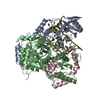 8psuC 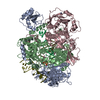 8pszC  8pt2C 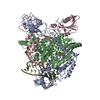 8pt6C 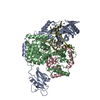 8pt7C 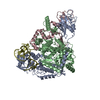 8pthC 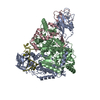 8ptjC  8qz8C M: map data used to model this data C: citing same article ( |
|---|---|
| Similar structure data | Similarity search - Function & homology  F&H Search F&H Search |
- Links
Links
- Assembly
Assembly
| Deposited unit | 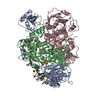
|
|---|---|
| 1 |
|
- Components
Components
-Protein , 3 types, 3 molecules ABC
| #1: Protein | Mass: 47780.508 Da / Num. of mol.: 1 Source method: isolated from a genetically manipulated source Source: (gene. exp.)  Tilapia lake virus / Production host: Tilapia lake virus / Production host:  Trichoplusia ni (cabbage looper) / References: UniProt: A0A142I7Z3 Trichoplusia ni (cabbage looper) / References: UniProt: A0A142I7Z3 |
|---|---|
| #2: Protein | Mass: 57179.375 Da / Num. of mol.: 1 Source method: isolated from a genetically manipulated source Source: (gene. exp.)  Tilapia lake virus / Gene: PB1 / Production host: Tilapia lake virus / Gene: PB1 / Production host:  Trichoplusia ni (cabbage looper) / References: UniProt: A0A1Y9SHW4 Trichoplusia ni (cabbage looper) / References: UniProt: A0A1Y9SHW4 |
| #3: Protein | Mass: 53782.141 Da / Num. of mol.: 1 Source method: isolated from a genetically manipulated source Source: (gene. exp.)  Tilapia lake virus / Production host: Tilapia lake virus / Production host:  Trichoplusia ni (cabbage looper) / References: UniProt: A0A7G3S745 Trichoplusia ni (cabbage looper) / References: UniProt: A0A7G3S745 |
-RNA chain , 2 types, 3 molecules VSP
| #4: RNA chain | Mass: 12736.518 Da / Num. of mol.: 2 / Source method: obtained synthetically / Source: (synth.)  Tilapia lake virus Tilapia lake virus#5: RNA chain | | Mass: 6675.037 Da / Num. of mol.: 1 / Source method: obtained synthetically / Source: (synth.)  Tilapia lake virus Tilapia lake virus |
|---|
-Non-polymers , 3 types, 6 molecules 
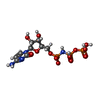



| #6: Chemical | | #7: Chemical | ChemComp-A0I / [( | #8: Chemical | |
|---|
-Details
| Has ligand of interest | Y |
|---|
-Experimental details
-Experiment
| Experiment | Method: ELECTRON MICROSCOPY |
|---|---|
| EM experiment | Aggregation state: PARTICLE / 3D reconstruction method: single particle reconstruction |
- Sample preparation
Sample preparation
| Component | Name: Tilapia lake virus polymerase / Type: COMPLEX / Entity ID: #1-#5 / Source: RECOMBINANT |
|---|---|
| Source (natural) | Organism:  Tilapia lake virus Tilapia lake virus |
| Source (recombinant) | Organism:  Trichoplusia ni (cabbage looper) Trichoplusia ni (cabbage looper) |
| Buffer solution | pH: 8 |
| Specimen | Embedding applied: NO / Shadowing applied: NO / Staining applied: NO / Vitrification applied: YES |
| Vitrification | Cryogen name: ETHANE |
- Electron microscopy imaging
Electron microscopy imaging
| Experimental equipment |  Model: Titan Krios / Image courtesy: FEI Company |
|---|---|
| Microscopy | Model: FEI TITAN KRIOS |
| Electron gun | Electron source:  FIELD EMISSION GUN / Accelerating voltage: 300 kV / Illumination mode: FLOOD BEAM FIELD EMISSION GUN / Accelerating voltage: 300 kV / Illumination mode: FLOOD BEAM |
| Electron lens | Mode: BRIGHT FIELD / Nominal defocus max: 2000 nm / Nominal defocus min: 800 nm |
| Image recording | Electron dose: 40 e/Å2 / Film or detector model: GATAN K3 BIOQUANTUM (6k x 4k) |
- Processing
Processing
| EM software |
| ||||||||||||||||||||||||
|---|---|---|---|---|---|---|---|---|---|---|---|---|---|---|---|---|---|---|---|---|---|---|---|---|---|
| CTF correction | Type: PHASE FLIPPING AND AMPLITUDE CORRECTION | ||||||||||||||||||||||||
| Symmetry | Point symmetry: C1 (asymmetric) | ||||||||||||||||||||||||
| 3D reconstruction | Resolution: 2.96 Å / Resolution method: FSC 0.143 CUT-OFF / Num. of particles: 29892 / Symmetry type: POINT | ||||||||||||||||||||||||
| Atomic model building | Protocol: AB INITIO MODEL / Space: REAL | ||||||||||||||||||||||||
| Refine LS restraints |
|
 Movie
Movie Controller
Controller














 PDBj
PDBj
































